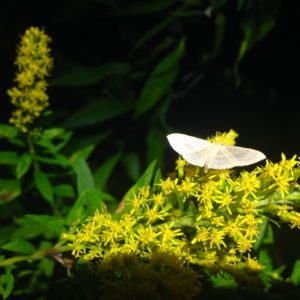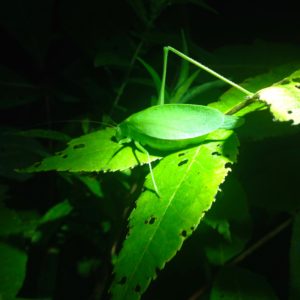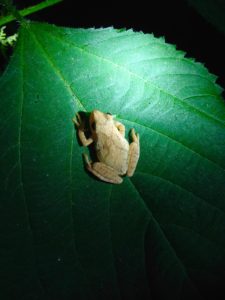In my experience, daytime is for fieldwork and the evenings are for campfires. However, this past summer I spent more time outside in the evening for fieldwork than I did in previous years, conducting amphibian surveys and helping out with bat surveys. People often associate walking around the woods at night with horror movies. I’m here to tell you this is not the case.
Earlier this month I spent an evening helping out with a bat survey in southern Ontario. I’ve been to this site before during the day, but at night it’s a different place. We arrive about a half hour after sunset. At dusk, it’s just light enough to see the last few birds fly over before settling for the night and the bats are starting to coming out. These animals can easily be missed if we don’t look up. They flit about and sometimes dip low, making their flight distinctive from birds. There’s a short time frame at dusk where you can see them flying above, but once the night sets in they are next to impossible to make out.
Bats find their way with echolocation calls at a higher frequency than what is detectable by human hearing. Sometimes we can hear the chattering of bats if we’re near a roost, and every once in a while I can hear a faint sound of a low frequency echolocation. We were using two kinds of bat detectors: one that strictly records and one that converts high frequency sounds into sounds humans can hear, to give us an idea of the bat activity in real time. We put on our headlamps, test the bat detectors, and we’re off.
As we set off to walk the transect the sky quickly darkens. In the fading light I can’t see more than a meter or two in front of me. The crickets and cicadas fill my ears. Sometimes I miss a low branch and get a reminder to look up from the ground once in a while. I can’t help but feel more vulnerable. It is more difficult to navigate, even on familiar trails. A good headlamp and a compass is a must.
Well into the transect I start to feel more comfortable. It also helps to have a field partner, especially one to lead the way and encounter the spiderwebs first! I recognize the trail and different parts of the property. We walk through the meadow I helped seed and the wetland I helped plant plugs in. The evening is a busy time for wildlife. During certain sections of the property, bat activity is almost continuous. But we also encountered pollinating moths, a katydid, and heard coyotes yipping not too far off.


By the end of the survey the stars are out, the temperature has dropped slightly, and the bats have been recorded. Another successful survey completed and it’s time to turn in for the night.
Of course there are more than bats to see or hear on a given night. Some of the highlights from my previous night time excursions include being deafened by the sound of spring peepers finding a mate in the early spring, fields lit up by fireflies by the end of June, and coming across different eye shines of nocturnal animals throughout the year.

Going outside at night is not as scary as Hollywood would have us believe. In fact it gives a whole new perspective to an area you may be very familiar with during the day. It becomes a whole new place to explore. If you think you know a place, go for a walk there at night to see the difference. Or you can join a night hike, or just sit, listen, and watch, preferably somewhere away from streetlights. You’ll be amazed at what you might find.